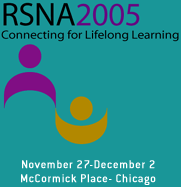
Abstract Archives of the RSNA, 2005
Shlomit Goldberg BA, Presenter: Nothing to Disclose
Bernard Dannenberg MD, Abstract Co-Author: Nothing to Disclose
Craig Albanese MD, Abstract Co-Author: Nothing to Disclose
Hans Ringertz MD, PhD, Abstract Co-Author: Nothing to Disclose
Richard Allen Barth MD, Abstract Co-Author: Nothing to Disclose
The frequency of pediatric CT exams continues to increase despite ALARA and estimates that CT radiation risk in children is significant. Our aim was to evaluate the efficacy of a protocol designed to reduce pediatric CT exposure by using graded compression sonography (US) as the primary imaging modality in pediatric appendicitis, with CT as a complimentary study applied only after a nondiagnostic US exam.
Following IRB approval, records of children presenting to the Emergency Department (ED) between January 2003 and February 2005 with suspected appendicitis were retrospectively reviewed. The protocol required children to receive US first and CT only after a nondiagnostic US. A low threshold for CT after a nondiagnostic US was encouraged to promote the use of US first and to minimize the failure to correctly diagnose appendicitis. All exams (US, CT) had been prospectively interpreted as showing positive, negative, or indeterminate findings for appendicitis. Histopathology was reviewed for concordance with imaging diagnoses. Negative appendectomy rate (NAR) was determined.
Records of 129 patients (mean age 11.2 years, range 1.5-18 years) were reviewed. Twenty-nine patients did not require imaging (NAR 0%), and 29 patients had CT first. Seventy-one patients underwent US as the first imaging study. Of these, 32 had a diagnostic US for appendicitis and concordant pathology. Thus, 45% of patients having US first were appropriately spared CT radiation, and the NAR for US first was 0%. Another 7 patients underwent CT in spite of a positive US, and all had concordant pathology, raising the potential radiation spared to 55% of US first patients. US failed to diagnose appendicitis in 16 cases. However, given our low threshhold for CT with nonproductive US, all 16 cases were corectly diagnosed on subsequent clinical exam or CT.
Triage of children with suspected appendicitis using US as the primary imaging modality is efficacious, and should reduce the need for pediatric CT exposure. A low threshold for CT given a nondiagnostic US facilitated the implementation of US first, allowed 45% of US first patients to be spared CT radiation, and yielded an NAR for US alone of 0%.
Goldberg, S,
Dannenberg, B,
Albanese, C,
Ringertz, H,
Barth, R,
US as the Primary Imaging Modality in Pediatric Appendicitis. Radiological Society of North America 2005 Scientific Assembly and Annual Meeting, November 27 - December 2, 2005 ,Chicago IL.
http://archive.rsna.org/2005/4410370.html

